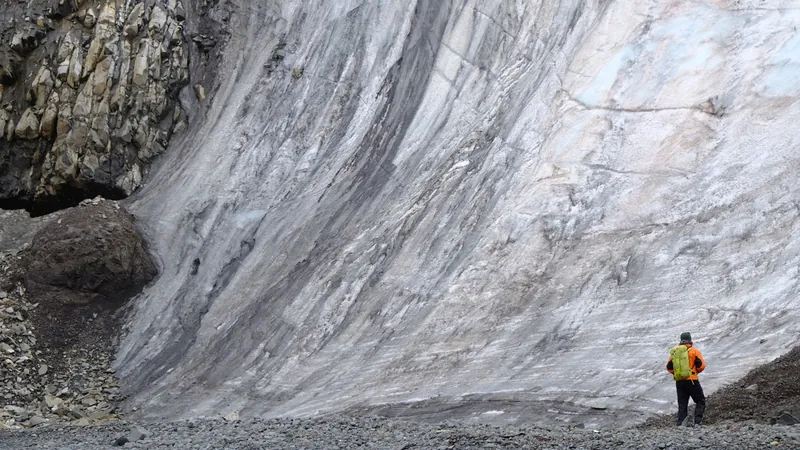
Shocking Discovery: Algae Accelerating Antarctic Ice Melt at Alarming Rate!
2025-05-09
Author: Ming
In an astonishing turn of events, a team of researchers led by Alex Thomson, an algal ecologist from the Scottish Association for Marine Science, uncovered a thriving ecosystem of microalgae on Robert Island, Antarctica—sparking a reevaluation of the impact these organisms may have on ice melting.
While scientists have long known about microscopic algae thriving in Arctic regions, their presence on Antarctic ice caps had largely remained a mystery. During their 2023 expedition, Thomson and his colleagues took the initiative to gather samples from the Robert Island ice cap, leading to a groundbreaking revelation.
Under the microscope, the ice samples revealed an unexpected hub of algal activity. "We began to realize as the field season progressed just how critical our observations of the ice cap were," stated Thomson.
Alarming Findings: Algal Blooms Are Everywhere!
A study published in *Nature Communications* unveils the startling extent of these algal communities, warning that their pigments, which absorb sunlight, could significantly amplify the rate at which Antarctic ice melts. According to Alexandre Anesio, an Arctic algae expert, this marks the first study quantifying such processes in Antarctica.
Researchers scoured 198 locations and utilized WorldView-2 satellite imagery from February 2023. The results revealed that approximately 20% of the ice cap's surface exhibited signs of algal growth, indicating that these blooms may constitute one of the largest photosynthetic habitats in the region.
Diverse Algae: A Hidden World Beneath the Ice!
Previously, estimates suggested that all photosynthetic life in Antarctica spanned about 44 square kilometers. Remarkably, the algal blooms on Robert Island alone could account for roughly 6% of this area. The research uncovered an astonishing variety of species, including the prominent genus Ancylonema, characterized by its unique elongated shape and ability to form chains.
Genetic analyses revealed not only similarities to Arctic Ancylonema species but also unique lineages that hint at a long evolutionary history isolated in Antarctica.
The Dark Side of Algae: Accelerating Ice Melt!
While exploring the diverse algae populations excited researchers, the implications of their findings are troubling. Using an innovative light-measuring device, resembling a gadget from *Ghostbusters*, the team discovered that ice surfaces with algal presence reflect significantly less sunlight compared to algae-free areas.
The purple pigment found in Ancylonema absorbs more solar energy, leading to increased heating of the surrounding ice. Their models suggest that algae contribute about 2% to daily melting rates on the ice cap. Although this may seem modest compared to Greenland, where algae can amplify melting by a staggering 13%, scientists are concerned that rising temperatures will further catalyze algal growth, exacerbating ice melt.
Urgency for Climate Models!
As it stands, current climate models overlook the role of microorganisms in ice melting. Both Anesio and Thomson stress that this oversight needs immediate attention, with Anesio stating, "This study serves as a crucial preview of possible changes in Antarctica should warm summers become the norm."
With this remarkable discovery, the scientific community is urged to reevaluate the future of Antarctic ecosystems and the rapidly changing dynamics of our planet's ice.



 Brasil (PT)
Brasil (PT)
 Canada (EN)
Canada (EN)
 Chile (ES)
Chile (ES)
 Česko (CS)
Česko (CS)
 대한민국 (KO)
대한민국 (KO)
 España (ES)
España (ES)
 France (FR)
France (FR)
 Hong Kong (EN)
Hong Kong (EN)
 Italia (IT)
Italia (IT)
 日本 (JA)
日本 (JA)
 Magyarország (HU)
Magyarország (HU)
 Norge (NO)
Norge (NO)
 Polska (PL)
Polska (PL)
 Schweiz (DE)
Schweiz (DE)
 Singapore (EN)
Singapore (EN)
 Sverige (SV)
Sverige (SV)
 Suomi (FI)
Suomi (FI)
 Türkiye (TR)
Türkiye (TR)
 الإمارات العربية المتحدة (AR)
الإمارات العربية المتحدة (AR)